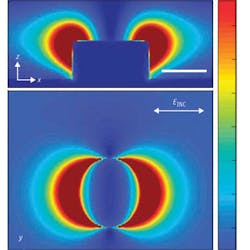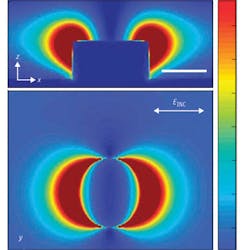OPTICAL TWEEZERS/INTRACELLULAR IMAGING: Plasmonics enables high-performance, next-gen optical tweezers
Plasmonic nanotweezers that produce strong forces more efficiently than traditional optical tweezers promise to facilitate the study of viruses, proteins and other nanoscale particles. The next-generation device features a heat sink—incorporating silicon coated in copper and then gold (in place of the traditional glass, which is less thermally conductive) and raised gold pillars. The setup enables reduction of water heating by 100-fold, thereby solving a longstanding problem of tweezers based on surface plasmons.1
Researchers at Harvard University’s School of Engineering and Applied Sciences (SEAS; Cambridge, MA) developed the device by applying the discovery that the trapping field could be enhanced by focusing laser light onto nanoscale gold disks arrayed on a glass sheet. The principle enabled them to trap polystyrene balls as small as 110 nm using the hotspots that appear at the top edges of the pillars, and then spin the particles around the pillars by rotating the linear polarizer on the optical table. They were able to automate the particle’s continuous travel around the pillar by replacing the linear polarizer with a circular one.
The electromagnetic field circling the pillar creates an optical force able to push the particle; the balance between the optical force and the fluid drag results in an effectively terminal velocity of about 5 rotations per second—a novel phenomenon.
The researchers now aim to detect and quantify the motion of the tiny particles.
1. K. Wang et al., Nature Comm. 2, 469 (2011).
More BioOptics World Current Issue Articles
More BioOptics World Archives Issue Articles

